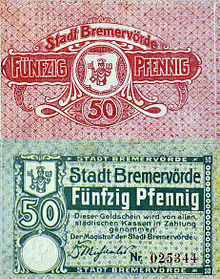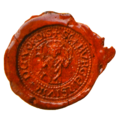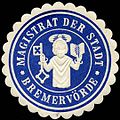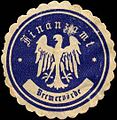History of Bremervördes
The history of Bremervörde goes back to the 8th century and is characterized by numerous conquests, the peat trade , the bog colonization and the development of the river Oste that runs through Bremervörde .
Prehistory and early history, early Middle Ages
B.C
The traces of the population in the area of today's Bremervörde go back to the Stone Age. Flint stones, scrapers, arrows and points, hammer stones and other materials found in the valleys of the Oste, Bever, Balbecksbach, Vossberg and Finkenmoor point to a population that already existed around 8000 to 3000 BC. A megalithic or tumulus from the Younger Stone Age (3000-1700 BC) was discovered between the present-day districts of Engeo and Spreckens . In the north of Engeo there is another barrow built on sandy ground.
8th century
Brunsburg
Around the year 800 - according to unoccupied records - a moated castle was built on a moor pass near Bremervörde (highest point in today's local area) on behalf of Charlemagne . This should serve as a stage security for transports and passing people. The castle consisted of a palisade wall and a surrounding moat. Today the Brunsburg street , which runs parallel to the railway line, is reminiscent of the castle .
9th and 10th centuries
Mention Engeos
In 937, the then village and today's district Engeo, in a document from King Otto I of the Saxon family of the Liudolfinger, the St. Moritz monastery in Magdeburg , which he founded , was transferred to Engeo. The document, dated October 11, is currently a copy from the 15th century in the Magdeburg State Archives.
10th to 13th centuries
Moated castle in Bremervörde
In a directory of the archbishop's property and rights, which was made by the Archbishop of Bremen Johann III. Rohde had put together around 1500, there are records of a moated castle on the Oste in Bremervörde that existed around the year 1000. The builder and owner are not known. It is known, however, that the Franconian castle was square, an inspiration based on the Brunsburg is possible.
You can see the floor plan or the outlines of the moated castle, which was already known as the "Old Castle" at the time, on a copper engraving made in 1646 based on a drawing made by the Swedish Field Marshal Conrad von Mardefeldt .
Mentioned as "Vorde"
The first mention of the name "Vorde" occurred in the 12th century when the Holstein clergyman Helmold von Bosau mentioned in his reports between 1167 and 1172 the taking over and "strengthening of the castles of Stade, Vorden and Freiburg (Elbe)".
14th Century
Fight for Vörde Castle
Since Vörde Castle was the most important or one of the most important castles of the Bremen archbishops, it was often the scene of battles between candidates for the archbishopric. A “fateful” reign of the Archbishop of Bremen Albert II of Braunschweig-Lüneburg, who died in Bremervörde on April 14, 1395, is described . Due to his lavish lifestyle, he often suffered from financial difficulties and as a result had to pledge church goods and rights.
15th and 16th centuries
Thirty Years' War
During the Thirty Years War Bremervörde was besieged several times by imperial, Danes and Swedes, for example in 1627 and 1646. Since the place was largely destroyed, the Swedes moved the seat of government of their newly created Principality of Bremen-Verden to Stade . The place suffered another siege in 1657 during the First Northern War or Danish-Swedish War. In 1682 Vörde Castle was finally demolished and the castle buildings demolished. Only the former chancellery of the Archbishops of Bremen and Verden from around 1608 remained, today's 'Alte Kreishaus'. The building material obtained was used, among other things, for the construction of the Swedish warehouse in Stade.
Late 16th century to early 17th century
Plague epidemic 1612
Like many cities or “conurbations” for the time, Bremervörde was not spared from the plague . The plague spread in Bremen in 1611 and finally found its way into Bremervörde in the summer of 1612. Not much is known about the number of sick, dead, lethal or survivors. It has been reported, however, that the archbishop at the time moved his office from Bremervörde to Stade to the Benedictine monastery of St. Marien for the duration of the plague outbreaks . The monastery tried in vain to prevent the archbishop from doing this.
Bremervörder pharmacy
In contrast to the pharmacies that only emerged in the 13th century, medical and pharmaceutical knowledge had been widespread among the people for thousands of years. Monasteries from the 9th century already had their own “monastery pharmacy”. The pharmacy established in Bremervörde in 1626 was, together with the Stader and Otterndorfer pharmacies, one of the first in the area between the Niederelbe and Niederweser. In Bremervörde, however, pharmacists were already working before 1626, but exclusively in the service of the archbishops of Bremen at the time, who were part of their staff.
The “privilege” is precisely dated to March 24, 1626 in a certificate issued by the archbishop's office (today the former district house), which privileged the pharmacist Caspar Rumpff to set up a pharmacy in Bremervörde. Archbishop Johann Friedrich thought this was necessary as the population was still plagued by the plague. The pharmacy should use the drug "Remedia" to combat them.
| Time of ownership or start |
Surname | Remarks |
|---|---|---|
| March 24, 1626 | Caspar Rumpff | |
| 1651 | Hinrich Wehausen | |
| 1671 | Dr. med. Joh. Praetorius | |
| 1680 | Rotger Kieff | After his death, his widow had to file for bankruptcy because of the debts she left behind |
| 1696-1715 | Eberhard Koenig | |
| 1730 | Johann Wilhelm Seidler | Left Bremervörde due to debt |
| 1747 | Johann Hinrich Krüger | Death in 1757 |
| 1823 | Johann Hieronymus |
18th and 19th centuries
Schützengesellschaft zu Bremervörde
The Bremervörde Schützengesellschaft has its origins in the 18th century. The first time a so-called "bird shooting" was held in 1843, which enjoyed great demand in the following years, resulting in the folk festival "Schützenfest".
A special feature of the Bremervörde riflemen at that time was the uniform consisting of long green jackets called “skirts” reaching to the knees as well as a green “cloth cap” with a silver horn on it. (See picture) The tradition of this uniform is continued by the "Traditionsgruppe" , a subsidiary of the Schützengesellschaft zu Bremervörde eV .
Bremervörde becomes a city
At the time of Napoleon Bonaparte , Bremervörde was the canton capital in the Kingdom of Westphalia . In the 19th century, Bremervörde was given a city constitution according to the state constitution , which was enacted in 1833 by King Wilhelm IV of Hanover. The mayor at the time, Friedrich Conrad Degener, called on April 26, 1834 a citizens' meeting to decide whether the Bremervörde area would agree to the change in law. The advantages mentioned were that Bremervörde would then regain its own jurisdiction and the previous rights of the area would be secured. Degener saw the economic and cultural opportunities of the city of Bremervörde if it were given a city constitution.
In 1835, Degener finally reported to the Royal Office after heated discussions with citizens. This was rejected due to a "non-existent advantage" for Bremervörde - determined by the responsible office - or further requests were not answered. It was not until 1837 that the first draft constitution was sent, which in 1845 then complied with all the wishes of Bremervörde. The constitution came into force on August 1, 1847. After the city regulations were adopted on January 3, 1852, Bremervörde was finally awarded the title of “city” on October 1, 1852.
Bremervörde volunteer fire department
founding
The origins of the fire brigade in Bremervörde go back to the year 1794, in which the former town of Bremervörde acquired a fire engine . At that time every citizen was still obliged to support the fire fighting.
Up until 1902, new fire engines or "water vehicles" were constantly being purchased, the organization of the fire fighting was changed and several fire fighting houses were built. In that year, the then mandatory fire brigade was dissolved and the Bremervörde volunteer fire brigade was founded, which received the first motorized vehicle in 1922.
The fire department today
The current municipal fire station was built in 2006 and is located in the southwest industrial area near the federal road 71 and is therefore tactically well located in the city area. The fire station has eight vehicle parking spaces, which are equipped with an exhaust extraction system, electricity and air pressure supply. Next to the vehicle hall there is a washing hall for cleaning vehicles and filling up foam compound containers . All exits are provided with automatic sectional doors .
In addition to the city fire brigade, there are 10 other local fire brigades in the city, which are organized in the Bremervörde District Fire Brigade Association.
| District | vehicles | Fire department designation |
|---|---|---|
| Bevern | LF, TLF | base |
| Elm | TSF , TLF | Basic equipment expanded |
| Hesedorf | LF, MTF | Basic equipment expanded |
| Hönau-Lindorf | TSF | Basic equipment |
| Iselersheim | MLF, MTF | Basic equipment expanded |
| Mehedorf | TSF | Basic equipment |
| Minstedt | TSF | Basic equipment |
| Lower Ochtenhausen | LF, MTF | Basic equipment expanded |
| Ostendorf | TSF | Basic equipment |
| Sprecks | TSF | Basic equipment |
20th century
Community reform
By resolution of the Lower Saxony state parliament on May 25, 1973 - with a narrow majority - it was decided to include the communities of Bevern , Elm , Hesedorf , Hönau-Lindorf , Nieder Ochtenhausen , Iselersheim , Mehedorf , Minstedt , Ostendorf , Plönjeshausen and Spreckens in the city of Bremervörde. Excerpt from the Bremervörder Zeitung of May 26, 1973:
"The die is cast! The Lower Saxony state parliament passed the law on the reorganization of the communities in the Bremervörde area yesterday with a narrow majority in the second and third consultation. Section 6 reads: The communities of Bevern, Elm, Hesedorf, Hönau-Lindorf, Nieder Ochtenhausen, Iselersheim, Mehedorf, Minstedt, Ostendorf, Plönjeshausen and Spreckens will be incorporated into the city of Bremervörde. In other words, this means that the Bremervörde unitary community has been resolved - against the decision of the council at the last council meeting, at which five minutes to twelve with 21 to 2 votes in favor of an integrated community. "
After the decision of the state parliament, the citizens of Bremervörde saw it as not changeable from the start. On March 1, 1974, the 11 localities were incorporated into the city of Bremervörde.
District reform
The plan of the Lower Saxony state parliament to reduce the 60 existing districts in Lower Saxony to 26, which was already in the "drawers" of the state parliament in 1969, was taken up again on January 9, 1970 in Bremervörde. The district council of the Bremervörde district opposed a reorganization of the districts from November 1969, which provided for the unification of the Bremervörde district and the Rotenburg (Wümme) district. Unity and independence of the district were required, because the Bremervörde district, with around 73,000 inhabitants and an area of 1240 km², is able to carry out an administration that will also meet future requirements.
Between the years 1970–1976, numerous citizens' initiatives - first of all the "Bremervörde District" initiative - were founded, the lights in Bremervörde shops were switched off for 15 minutes on December 9, 1976 and car stickers with the words "Save the Bremervörde District" were distributed.
Nevertheless, by law of June 28, 1977 and with effect from August 1, 1977, the districts of Rotenburg (Wümme) and Bremervörde were united. The new district seat is Rotenburg (Wümme). Well-known headlines at that time were "The Bremervörde district has been wiped out" and "Bremervörde is losing its administrative headquarters". Only a few boundary stones and the former "Bremervörde District House", which has become a branch of the Rotenburg (Wümme) district, have remained.
Vörder See
Today, the Vörder See is the landmark of Bremervörde. In the past, where the lake is now, there were acidic meadows with poor soil quality - due to the former course of the Oste there - and sandy subsoil. When the farmers gradually gave up the difficult management of the meadows, the Bremen city council came up with the idea in 1968 to flush out the meadow area and turn it into a water sports area. This suggestion received a great deal of approval, so that the rinsing work began in 1972. Until the completion of the lake, which is rich in bays, in 1978, the project cost around 3 million German marks . The resulting 1 - 1.25 million m³ were used to reinforce the Ostedeich and to fill in low-lying houses.
Bremervörde today
traffic
Today Bremervörde is an important traffic junction of the Elbe-Weser triangle. The federal highway B74 , which runs through the local area, connects Bremervörde with Berne (near Bremen) and Stade. The B71 coming from the west into the local area and leaving it in the south connects Bremervörde with Bremerhaven and Magdeburg . Due to the high frequency of these federal highways (sometimes up to 15,000 - 24,000 vehicles per day), especially on the section running through the inner city, longer traffic jams and delays occur at peak times.
The next junctions of the federal motorway 1 are in Bockel , Sittensen and Elsdorf . The Bremerhaven – Buxtehude train connection connects Bremervörde with Buxtehude and Bremerhaven and other Bremerhaven junctions such as Hamburg and Bremen.
tourism
Bremervörde is a state-approved resort. Bremervörde is an attractive destination for cyclists thanks to its numerous cycle paths, particularly through nature reserves and rivers. With the Oste and various other rivers such as the Bever , Bremervörde also has points of attraction for canoeists and kayakers, and on the Unteroste also motorboat enthusiasts. The Bremervörde nature and adventure park, established in 1991, and the Vörder See also offer families an attractive travel destination.
The Bremervörde port
The local authority at that time was convinced that every citizen could get basic food cheaply. On October 30, 1800, the mayors "Lange" and "Tolle" issued an ordinance that forbade traders docking in the Bremervörde port to sell their goods in large quantities to "profit-addicted sellers", but to have them declared in accordance with the regulations . The “calling out” of the goods (onions, cabbage and white cabbage often around the 18th century) was intended to ensure that the citizens were adequately supplied with food. Frequent violations of this regulation and the "Polizey -ordnung" were handed down, which forced the administration at the time to issue harsh threats to boatmen, traders and citizens and to threaten punishments.
Was the port of Bremervörde in the 19th and early 20th century as the end point of the navigable Oste an important transit point for about Oereler channel , the Oste-Hamme Canal , the Frese Burger channel and the Oste-rocker channel transported peat from the Teufelsmoor as well as for Stackbusch , which was transported on by Ewern . At the turn of the century, the port was the main traffic center of the city. Not only peat, but also other “bulk goods” such as lime, cement, grain and masonry were transported by water.
With the improvement of land-based transport routes and motorization in the 20th century, however, river navigation lost its importance completely. Today the port is used by private sailors and motorboat drivers.
Incorporations
On March 1, 1974 were part of the government reform the then independent municipalities Bevern, Elm, Hesedorf in Bremervörde, Hönau-Lindorf, Iselersheim, Mehedorf, Minstedt, Lower Ochtenhausen, Ostendorf, Plönjeshausen and Spreckens incorporated.
Historical Bremervörder means of payment
At the time of the German inflation , which affected Bremervörde from 1919 to 1923, the value ratio also changed drastically in Bremervörde. At that time, the emergency money issued by Bremervörde was an art in itself . Each of these banknotes had a consecutive number. Formulations such as “This banknote will be accepted as part of payment by all municipal coffers” and the signature of the Bremen municipal authorities were often printed on the banknote.
In the period around 1923 a modified form of the verse made famous by the painter-poet Wilhelm Busch , "It's beautiful all over the world, but most beautiful in Bremervörde" was printed. Wilhelm Busch stayed in Bremervörde in 1878 due to the marriage of his brother Hermann Busch to the Bremen sponsor Elisabeth Schönian.
| time | Ratio 1 US dollar = German mark |
|---|---|
| January 1919 | 8 - 9 marks |
| December 1919 | 42-48 marks |
| January 1920 | 50-83 marks |
| December 1920 | 69 - 73 marks |
| January 1921 | 60 - 75 marks |
| December 1921 | 184-190 marks |
| January 1922 | 187 - 201 marks |
| December 1922 | 7,350 - 7,650 marks |
| January 1923 | around 49,000 marks |
| June 1923 | 154,500 marks (strong fluctuations) |
| July 1923 | 1,000,100 marks |
| August 1923 | 10.3 million marks |
| September 1923 | 160 million marks |
| October 1923 | 730 billion marks |
Bremervörde seal
Seal from the 14th century
After 1800
literature
- Elfriede Bachmann, Rainer Brandt: BREMERVÖRDE Pictures from the history of a city . Bogardt Druck, Bremervörde 1987.
- Sparkasse Rotenburg-Bremervörde: 175 years of Sparkasse Rotenburg-Bremervörde . Druckerei Rosebrock GmbH, Sottrum 2012, ISBN 978-3-00-036867-7 .
Web links
- Official website of Bremervördes
- Bachmann Museum
- District archive of the Rotenburg (Wümme) district in Bremervörde
Individual evidence
- ↑ a b c d e f g h i j k l m Elfriede Bachmann, Rainer Brandt: BREMERVÖRDE Pictures from the History of a City , Bogardt Druck, Bremervörde 1987.
- ^ Albert II of Braunschweig-Wolfenbüttel
- ↑ Bremervörde District Fire Brigade Association
- ^ City of Bremervörde: City and traffic development
- ↑ Teufelsmoor-wattenmeer.de: Rotenburg (Wümme) ( Memento of the original from June 1, 2016 in the Internet Archive ) Info: The archive link was automatically inserted and not yet checked. Please check the original and archive link according to the instructions and then remove this notice.
Coordinates: 53 ° 29 ′ 0 ″ N , 9 ° 8 ′ 47 ″ E














